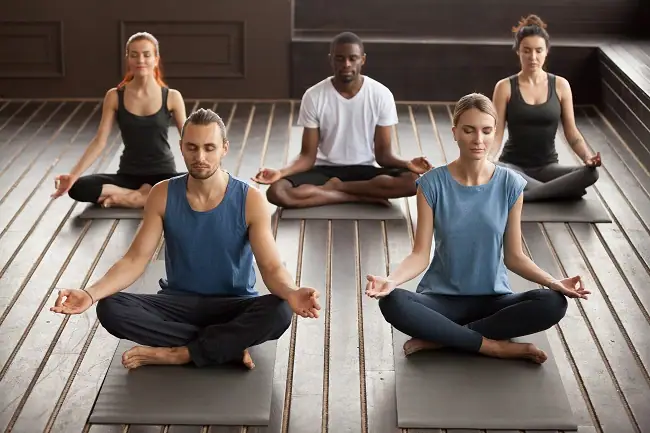Starting any new workout can be intimidating, and this is especially true for those just getting started with yoga. While yoga is a low-intensity, body-weight workout focused on breathing, movement, and stretches, getting started can be scary, especially with unfamiliar flows and terms.

Whether you’re looking to jump right in and try an hour-long hot yoga session or you’re experimenting with a chair yoga app , it’s key to understand the background and essentials of this practice. This article explains the basics of yoga, including the different types of yoga practices, the essential yoga equipment, etiquette, as well as a few basic poses so you have everything you need to know to start your yoga journey.
Essential Yoga Background
Yoga is an ancient Indian spiritual practice people have been practicing for over 5,000 years. Over the years, yoga has changed and evolved into different styles, but at its core, yoga balances physical postures with breathing techniques and meditation to promote overall health and well-being.
No two classes will practice yoga precisely the same way; some may prioritize relaxation and meditation while others use the poses to create intense physical workouts, so it’s important to find the type of class that works the best for you.
Primary Yoga Styles
As mentioned previously, there are a wide variety of yoga practices you can engage with. Most classes available are a variation of one of these five classes:
- Hatha Yoga: A traditional practice, focusing on poses and breath control. This type of practice is ideal for beginners.
- Vinyasa Yoga: Centered on the flow through each movement. These classes are dynamic and prioritize breathwork.
- Ashtanga Yoga: More rigorous. Expect an emphasis on strength, stability, and stamina.
- Bikram Yoga: Also known as hot yoga. This practice is completed in a hot room to remove toxins from the body through sweat.
- Yin Yoga: An extended pose practice. These classes prioritize form and mindfulness over movement.
Essential Yoga Equipment
Once you’ve chosen a yoga style and found a beginner class, you want to be familiar with the equipment your class is likely to use. Here are the basics:
- Yoga Mat: Most participants will bring their own, but some classes will also provide mats for their students. Yoga mats provide cushioning and stability for yoga poses, adding comfort as you move through the different poses. If you’re looking to buy your own, look for one with a non-slip back.
- Comfortable Clothing: Breathable, stretchy attire is your friend. Avoid baggy tops that will fall in your face if you expect to do inverted poses. Additionally, beware of bulky or restrictive clothing which may hinder your movements.
- Props: Common props for a yoga practice include blocks, straps, and bolsters. These items help students modify poses to make them more comfortable to complete, making them ideal for beginners. Most practices will provide these to participants at no additional cost, but you can also bring your own.
Basic Etiquette
Before your first yoga class, you should be aware of some basic etiquette and guidelines to ensure you and those around you have a positive experience.
- Arrive Early: Aim to arrive about 10 minutes before the start of class to allow time to set up your mat.
- Be Mindful of Your Space: This is a group workout class, so you should avoid wearing strong scents and silence your phone before the practice begins. Additionally, aim to have about 3 feet worth of space on either side of your mat when you set up; many poses will involve stretching your arms out, and you don’t want to risk hitting someone in the middle of the practice.
- Listen to Your Body: Avoid pushing yourself too hard in the first class. While it can be intimidating to watch the other students in your class, it’s likely this isn’t their first class. Allow yourself to take the necessary modifications when necessary and rest if you need a break.
- Stay Present: In addition to silencing your cell phone, you should also avoid talking to others during class. Listen to your instructor and focus on your breath and positioning.
Basic Yoga Poses
Though there are hundreds of yoga poses, there are many which are found in almost every practice. Here are a few essential poses you can practice at home before your first yoga class:
- Child’s Pose (Balasana): Sit on your mat on your heels and move your knees to the outer edge of your mat. Then, move your torso forward so your forehead rests on the ground, your arms extended on the ground in front of you.
- Downward-Facing Dog (Adho Mukha Svanasana): On your hands and knees, push your butt towards your back, extending your legs, but keeping a bend if necessary, to form an inverted V-shape. Focus on keeping your upper body in a straight line, your head in between your arms, and your shoulders by your ears.
- Corpse Pose (Savasana): The pose that ends almost every yoga practice. To complete this pose, lie flat on your back with your arms and legs extended. Your palms should face upward toward the ceiling. Close your eyes and relax completely, aiming to clear your mind.
Breathing and Meditation
Equally important to the poses in yoga are the breathing exercises. To practice these at home, take a few moments to sit without distractions and place a hand on your belly. When you inhale, focus on distending your stomach, filling your belly with air. As you exhale, pull the air from your belly slowly, allowing your hand to come back down. As you do this, focus on the rhythm of your breath, cultivating inner peace.
Conclusion
While starting yoga as a beginner may seem intimidating, there are many resources available for beginners and a variety of ways to find your particular practice. Try out different classes and find what works best for you as you work to cultivate your mind and body through this ancient meditation.







